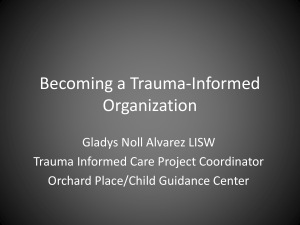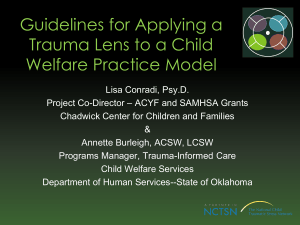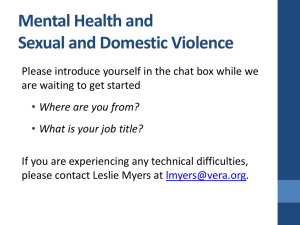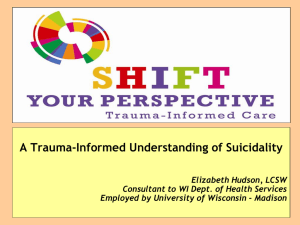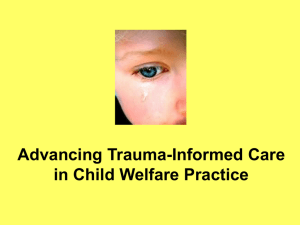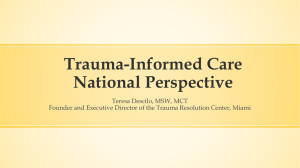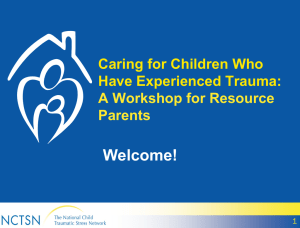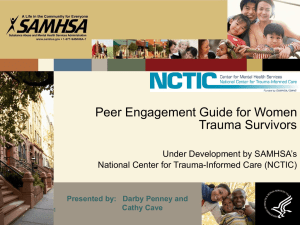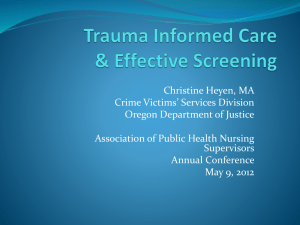Trauma-Informed Services
advertisement
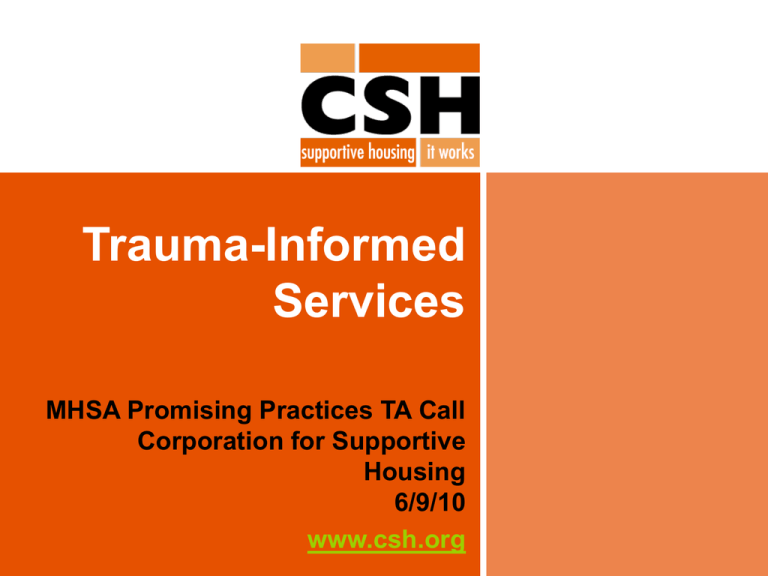
Trauma-Informed Services MHSA Promising Practices TA Call Corporation for Supportive Housing 6/9/10 www.csh.org Why Trauma-Informed Services? Homelessness is traumatic People experiencing homelessness are living with a multitude of losses: – A person who is homeless has lost their home, community, stability, safety, and social networks – They are marginalized, isolated, and stigmatized within the larger society 2 People who are experiencing homelessness are also highly vulnerable to violence and victimization What is Trauma? 3 Trauma is an emotional shock that creates significant and lasting damage to a person’s mental, physical and emotional growth, and overwhelms a person’s resources for coping. Typical causes of psychological trauma are: – Sexual abuse, violence, (and the threat of either, or the witnessing of either), catastrophic events such as earthquakes, war, mass violence, or longterm exposure to situations (ex: extreme poverty, verbal abuse) A traumatic event involves: – A single experience, or – An enduring or repeating event or events Behavioral Manifestations from Trauma 4 Depression Loneliness Ostracized Unaccepted Non-trusting Angry Jittery Sleeplessness Violent Confused Isolated Alone Rejected Misfit Low self-esteem Mood swings Hurtful Poor attachments Suicidal Emotionally unstable Self destructive Self injurious Nightmares Aggressive Rebellious Secluded Tease Drugs Alcohol Sexual activity Vengeful Sensitive Touchy Poor problem-solving Poor comprehension Slow cognition Depression Loneliness Ostracized Important Point: Different people will react differently to similar events. One person may perceive an event to be traumatic that another may not, and not all people who experience a traumatic event will become psychologically traumatized 5 Trauma-Informed Care Trauma-Informed Care (TIC) offers a framework for providing services to traumatized individuals within a variety of service settings, including homelessness service settings. Service systems are designed to accommodate the vulnerabilities of trauma survivors and allow services to be delivered in a way that will avoid inadvertent re-traumatization and to facilitate consumer participation in treatment. 6 Trauma-Informed Care Consensus-Based Definition “Trauma-Informed Care is a strengths-based framework that is grounded in an understanding of and responsiveness to the impact of trauma, that emphasizes physical, psychological, and emotional safety for both providers and survivors, and that creates opportunities for survivors to rebuild a sense of control and empowerment.” 7 Trauma-Informed Care 8 Findings from numerous studies suggest that we will be unable to solve the issue of homelessness without addressing the underlying trauma that is so intricately interwoven with the experience of homelessness. Principles of Trauma-Informed Care 9 Trauma awareness: – Trauma-informed service providers incorporate an understanding of trauma into their work – Staff training, consultation, and supervision are important aspects of organizational change towards trauma-informed care. – Dealing with vicarious trauma and self-care is also an essential ingredient of trauma-informed services. Principles of Trauma-Informed Care Emphasis on safety: – Program must provide a safe place – physically and emotionally – for consumers. – Providers should be aware of potential retraumatization. Because interpersonal trauma often involves boundary violations and abuse of power, programs should establish clear roles and boundaries that are an outgrowth of collaborative decision-making. – Privacy, confidentiality, and mutual respect are also important aspects of developing an emotionally safe atmosphere. – Acceptance of, and respect for, diversity is another important aspect of a safe environment. 10 How do our agencies retraumatize consumers? Not assisting survivors when they experience violations (e.g police harassment, victim of crime) Authoritarian staff Triggering memories of abuse ( e.g vocabulary, people, smells, sounds, the environment) Staff being non-responsive to the concerns survivors have Staff being impatient with survivors Verbal abuse from staff Stereotyping survivors Survivors hearing the traumatic experiences of others Placing too many expectations on survivors especially those with impaired functioning Being judgmental Disrespect Boundary violations Lack of consistency when applying rules (favoritism) Loud chaotic environment Unsafe environment 11 Principles of Trauma-Informed Care Principles of Trauma-Informed Care 13 Opportunities to rebuild control: – Trauma-informed services emphasize the importance of choice for consumers. – They create predictable environments that allow consumers to re-build a sense of efficacy and personal control over their lives. – This includes involving consumers in the design and evaluation of services. – Consumer choice and control are critical. Principles of Trauma-Informed Care 14 Strengths-based approach: – TIC is strengths-based, rather than deficitoriented, and assists consumers to identify their own strengths and develop coping skills. – TIC service settings are focused on the future and utilize skills-building to further develop resiliency. Review of Needs Assessments: Trauma-Informed Care 15 Providers feel that they need to be better informed about trauma and violence – Programs had little knowledge about trauma, how to facilitate recovery, or how services might help or retraumatize Providers do not have systematic ways of assessing for trauma-related issues – Assessments were generally not conducted systematically and did not utilize validated measures Review of Needs Assessments: Trauma-Informed Care 16 Consumers want services that are empowering – Qualitative research suggests that homeless individuals and families need and want traumainformed services, including desire for autonomy, prevention of further victimization, and assistance in restoring their devalued sense of identity Mental health services are an important need for many homeless families and individuals. – Mental health needs were the most prevalent of all the intervention needs across sites with many facing multiple challenges Assessment Tool 17 The National Center on Family Homelessness developed the Trauma-Informed Organizational SelfAssessment to translate the principles of traumainformed care into concrete practices that can be incorporated into daily programming in shelter and housing programs. This tool is designed to be used by programs to: 1) evaluate programming based on how well they incorporate Self-Assessment practices; 2) identify areas for organizational growth; and 3) make practical changes using the SelfAssessment as a guide. Assessment Tool 18 Trauma-Informed Organizational SelfAssessment I. Supporting Staff Development II. Creating a Safe and Supportive Environment III. Assessing and Planning Services IV. Involving Consumers V. Adapting Policies Resources To learn more about Trauma-Informed Services Resources Shelter from the Storm: Trauma-Informed Care in Homelessness Services Settings Elizabeth K. Hopper, Ellen L. Bassuk, and Jeffrey Olivet In The Open Health Services and Policy Journal, 2010, 3, 80-100 http://bentham.org/open/tohspj/openaccess2.htm 20 Resources 21 Trauma-Informed Organizational Toolkit for Homeless Services Guarino, K., Soares, P., Konnath, K., Clervil, R., and Bassuk, E. (2009). Rockville, MD: Center for Mental Health Services, SAMHSA, and the Daniels Fund, the National Child Traumatic Stress Network, and the W.K. Kellogg Foundation. Available at www.homeless.samhsa.gov and www.familyhomelessness.org. Resources The National Center for Trauma-Informed Care CMHS’s National Center for Trauma-Informed Care (NCTIC) is a technical assistance center dedicated to building awareness of traumainformed care and promoting the implementation of trauma-informed practices in programs and services. http://mentalhealth.samhsa.gov/nctic/ 22 For More Information: Anne Cory CSH anne.cory@csh.org (510) 251-1910, ext. 208
